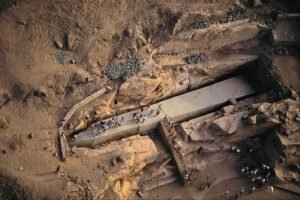Unfinished Obelisk in aswan
The Unfinished Obelisk: A Glimpse into Ancient Egyptian Stonecraft
Nestled in the northern quarry of Aswan, the Unfinished Obelisk stands as a testament to the incredible stoneworking skills of ancient Egypt. This remarkable monument, though never completed,

offers invaluable insights into the techniques and challenges faced by the craftsmen of the time. In this blog post, we’ll explore the history, significance, and fascinating details of the Unfinished Obelisk,
making it easy and enjoyable to understand this ancient wonder.
1. Historical Context of Unfinished Obelisk: A Project of Ambition
The Unfinished Obelisk is believed to have been commissioned by Queen Hatshepsut, one of ancient Egypt’s most successful and powerful pharaohs.
- Purpose: The obelisk was intended to be erected at the Karnak Temple in Luxor.
- Dimensions: If completed, it would have been the largest obelisk ever erected, standing at approximately 42 meters (137 feet) and weighing around 1,200 tons.
2. Craftsmanship: The Art of Stone Carving
The Unfinished Obelisk provides a unique opportunity to see the stoneworking techniques used by ancient Egyptians.
- Quarrying Process: The obelisk was carved directly out of the bedrock using dolerite stone tools, which are harder than the granite itself.
- Chisel Marks: Visitors can observe the chisel marks left by the workers, giving a tangible sense of their labor and skill.
- Techniques: The process involved carving trenches around the obelisk, then using wooden wedges soaked in water to expand and crack the stone away from the bedrock.
3. The Crack: A Monument Left Unfinished
The Unfinished Obelisk remains in its incomplete state due to a significant crack that developed during the carving process.
- Discovery: The crack was discovered when the obelisk was nearly complete, rendering it unusable.
- Impact: This flaw provides modern archaeologists with a unique look at the methods and tools used in ancient stoneworking.
4. Educational Experience of Unfinished Obelisk: Learning from the Past
Visiting the Unfinished Obelisk site offers an educational experience for all ages.
- Informative Displays: The site features informative displays and guides that explain the history and techniques used in the quarry.
- Hands-On Learning: Visitors can touch the granite and see the tools used, making it a tactile learning experience.
- Guided Tours: Knowledgeable guides are available to provide deeper insights and answer questions about the site and its significance.
5. Significance: A Symbol of Ancient Ingenuity
The Unfinished Obelisk is more than just an incomplete monument; it symbolizes the ingenuity and ambition of ancient Egyptian civilization.
- Engineering Marvel: The sheer size and scale of the obelisk highlight the advanced engineering skills of the ancient Egyptians.
- Cultural Importance: Obelisks were significant in ancient Egyptian culture, often associated with the sun god Ra and used to commemorate important events or individuals.
- Historical Insight: The Unfinished Obelisk provides historians and archaeologists with valuable information about the quarrying techniques and labor organization of the time.
6. The Quarry: A Historical Site in Itself
The northern quarry of Aswan, where the Unfinished Obelisk lies, is an important historical site.
- Granite Source: Aswan’s quarries were the primary source of granite for many of Egypt’s monuments, including those in Luxor and the pyramids of Giza.
- Other Artifacts: The quarry area also contains other unfinished projects and artifacts, offering a broader understanding of ancient Egyptian stoneworking.
- Preservation Efforts: Ongoing preservation efforts ensure that the site remains accessible and informative for future generations.
7. Visitor Experience: What to Expect
A visit to the Unfinished Obelisk site is a must for anyone interested in ancient history and engineering.
- Accessibility: The site is easily accessible from Aswan and often included in guided tours of the city’s attractions.
- Exploration: Visitors can walk around the obelisk, observe the quarrying marks, and explore the surrounding quarry area.
- Photography: The site offers excellent photo opportunities, capturing the scale and detail of the unfinished monument.
8. Connecting with History: A Personal Reflection
Standing beside the Unfinished Obelisk, one can’t help but feel a deep connection to the past.
- Human Effort: The visible chisel marks and unfinished state of the obelisk are a poignant reminder of the human effort and skill involved in its creation.
- Timelessness: Despite being thousands of years old, the site feels timeless, bridging the gap between ancient and modern worlds.
- Inspiration: The Unfinished Obelisk inspires awe and respect for the ancient Egyptians’ dedication and craftsmanship, encouraging visitors to appreciate the ingenuity of past civilizations.
Finally
The Unfinished Obelisk in Aswan is a fascinating and educational destination that offers a rare glimpse into the stoneworking techniques of ancient Egypt. Whether you’re a history enthusiast,
an engineering aficionado, or simply a curious traveler, the Unfinished Obelisk provides a unique and enriching experience. So, when you visit Aswan, make sure to take the time to explore
this incredible site and connect with the ancient world in a truly tangible way.








